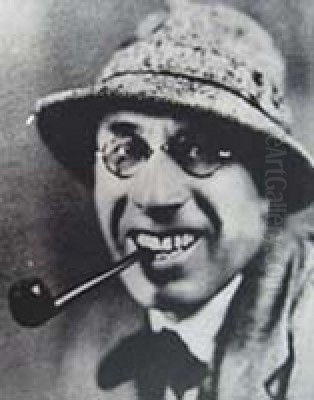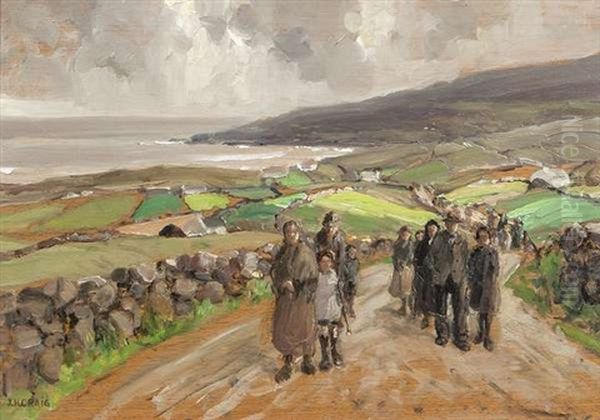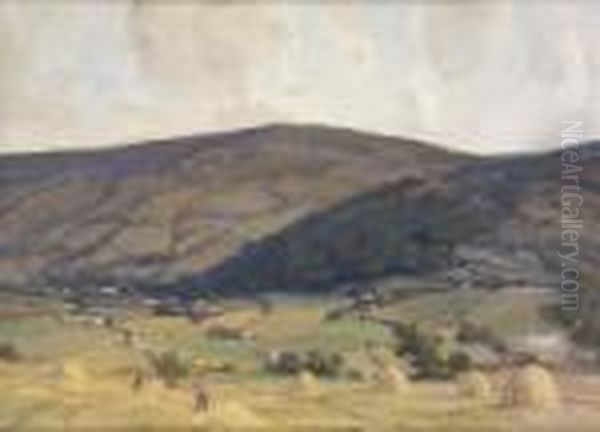
James Humbert Craig stands as a significant figure in the landscape of twentieth-century Irish art. Born in Belfast in 1877 and passing away in 1944, Craig dedicated his artistic life to capturing the rugged beauty and atmospheric light of his native land, particularly the regions of Ulster and the West of Ireland. Though his formal training was brief, his innate talent and profound connection to nature allowed him to become one of the most beloved and respected landscape painters of his generation, leaving behind a legacy of works celebrated for their sincerity, technical skill, and evocative power.
Early Life and Artistic Awakening
James Humbert Craig entered the world in Belfast, a city undergoing significant industrial and social change. He spent his formative years in the nearby coastal village of Ballyholme, County Down. His family background offered a blend of commerce and creativity; his father was a successful tea merchant, providing a stable foundation, while his mother hailed from a family with artistic inclinations. This maternal connection likely provided early encouragement and exposure to the world of painting, planting the seeds for his future path.
Despite this artistic lineage, Craig's journey to becoming a painter was not conventional. He enrolled at the Belfast School of Art, a natural step for an aspiring artist. However, his time there was remarkably short-lived. He famously failed to complete even a single term, suggesting either a dissatisfaction with formal academic methods, a restless spirit eager to engage directly with his subjects, or perhaps other undisclosed challenges. Whatever the reason, this departure marked him as primarily a self-taught artist.
This lack of extensive formal training did not hinder his development. Instead, Craig learned his craft through direct observation, relentless practice, and an immersive engagement with the landscapes that captivated him. His true classroom was the outdoors – the coasts, glens, and mountains of Ireland. This self-directed education fostered a style rooted in personal experience and a deep, intuitive understanding of his environment, rather than adherence to academic dogma. His passion for nature and the outdoor life became the driving force behind his art.
Forging a Style: Impressionism and the Irish Landscape

Craig's artistic heart belonged to the Irish landscape. He was particularly drawn to the dramatic scenery of County Antrim, with its famous Glens, the wild beauty of Donegal, and the unique light and atmosphere of Connemara in the West. These locations became recurring subjects throughout his career, providing endless inspiration for his canvases. He possessed an innate ability to see and translate the nuances of the Irish weather and light, from the bright, windswept days on the coast to the soft, misty atmosphere of the glens.
His style shows a clear affinity with the principles of Impressionism, particularly in its emphasis on capturing the fleeting effects of light and colour. Like the French Impressionists, Craig often worked outdoors (en plein air), allowing him to respond directly to the changing conditions and imbue his paintings with a sense of immediacy and freshness. His brushwork could be vigorous and expressive, effectively conveying the textures of rock, water, and foliage, as well as the movement of clouds and waves.
However, Craig was not merely imitating European trends. His work possesses a distinctly Irish sensibility. There is a sincerity and directness in his approach, a desire to represent the landscape faithfully without excessive romanticisation or artificial enhancement. He was quoted as believing in portraying nature as he found it, not attempting to 'improve' upon it. This honesty resonates in his paintings, which often depict not just the beauty but also the raw, untamed character of the Irish countryside.
An interesting, though possibly apocryphal or misunderstood, note from some sources mentions him painting the Brooklyn Bridge in London. Given the geographical impossibility, this might refer to a painting of a bridge in London, or perhaps a misattribution or error in translation within historical records. Regardless, his primary focus remained steadfastly on the landscapes of Ireland. A brief period spent living in the United States early in his career seemingly only strengthened his attachment to his homeland, as he soon returned to Ulster to fully dedicate himself to painting its scenery.
A Flourishing Career and Recognition
Craig's dedication and talent did not go unnoticed. His career gained significant momentum in 1915 when he first exhibited at the prestigious Royal Hibernian Academy (RHA) in Dublin. This marked the beginning of a long and fruitful relationship with the institution. Over the course of his life, he would exhibit an impressive total of 130 works at the RHA's annual exhibitions, establishing himself as a regular and respected contributor.

His standing within the Irish art establishment grew steadily. He was elected an Associate of the RHA (ARHA) and later achieved full membership as a Royal Hibernian Academician (RHA) in 1928. This recognition from his peers underscored the quality and significance of his work. Alongside his involvement with the RHA, Craig was also associated with the Royal Ulster Academy of Arts (RUA) in his native Northern Ireland, eventually becoming an Academician (RUA) there as well.
Beyond the major Irish academies, Craig's work found audiences in numerous other venues. He exhibited regularly with the Belfast Art Society and showed work at galleries such as the Magee Gallery. His reputation extended across the Irish Sea to London, where he exhibited at the Royal Academy (RA), the Royal Institute of Oil Painters (ROI), and the Fine Art Society. This exposure in London was crucial for building a broader reputation.
Craig's art also travelled internationally. His paintings were included in exhibitions held in continental Europe, including shows in Belgium (notably the Brussels International Exhibition in 1930), Switzerland, and Northern Italy. This international presence demonstrated the appeal of his distinctively Irish landscapes to a wider European audience during the interwar period.
The enduring quality of his work is further evidenced by its inclusion in major public collections. Today, paintings by James Humbert Craig can be found in the National Gallery of Ireland, the Hugh Lane Municipal Gallery of Modern Art in Dublin, and the Ulster Museum in Belfast, ensuring his contribution to Irish art history remains accessible to future generations.
Masterworks and Artistic Philosophy
Among Craig's extensive body of work, several paintings stand out as particularly representative of his style and preoccupations. Sunday Morning, Bloody Foreland is one such masterpiece. This work depicts figures gathering, presumably for a church service, against the dramatic backdrop of the North Donegal coastline. It masterfully captures the unique light and atmosphere of the region, balancing the human element with the powerful presence of the landscape. The interplay of light and shadow, the rendering of the sea and sky, showcase Craig's observational skills and his ability to evoke a specific time and place.
Other notable works further illustrate his focus on rural Ireland and its landscapes. Paintings like Cottages at Dunloe capture the simple, vernacular architecture nestled within the Kerry landscape, conveying a sense of harmony between human habitation and the natural world. Similarly, Figures Making Hay, Glendun, near Cushendun depicts agricultural life within the Antrim Glens, celebrating the connection between people and the land through the rhythms of seasonal work. These paintings are rendered with his characteristic honesty and attention to atmospheric detail.
Underpinning these works was Craig's consistent artistic philosophy. He remained committed to a truthful depiction of the world around him. His paintings are marked by their sincerity and lack of affectation. He sought to capture the essence of the Irish landscape – its light, its weather, its textures, its moods – without imposing an overly subjective or romanticised vision. This direct, unembellished approach gives his work an enduring authenticity and power. His focus was on observation and skillful rendering, letting the inherent beauty and character of the landscape speak for itself.
Craig in Context: Contemporaries and Influence
James Humbert Craig did not work in isolation. He was part of a vibrant generation of Irish artists active in the early to mid-twentieth century, a period when Irish art was forging a stronger sense of national identity while engaging with international movements. His work resonates particularly strongly with that of Paul Henry (1876-1958), arguably the most famous Irish landscape painter of the era. Henry's iconic depictions of the West of Ireland, particularly Achill Island, with their distinctive handling of clouds and light, certainly influenced Craig, and both artists shared a focus on capturing the atmospheric qualities of the Irish landscape, often favouring similar locations in the West.
Another close contemporary was Frank McKelvey (1895-1974), also from Belfast. McKelvey shared Craig's dedication to landscape painting, often depicting similar scenes in Ulster and Donegal. While their styles differed in nuances, they were kindred spirits in their commitment to representing the local environment with skill and sensitivity. They, along with artists like Charles Lamb (1893-1964) and Moira MacGonigal (1900-1979), were sometimes grouped together as key figures representing a particular strain of traditional Irish landscape and genre painting during this period.
Craig's interactions extended beyond shared subject matter. He was known to have connections with William Conor (1881-1968), another prominent Belfast artist famed for his depictions of working-class city life, suggesting a supportive network among Ulster artists. Furthermore, Craig played a role in encouraging younger talent. He served as a judge for a Celtic Design competition in 1929, awarding first prize to Charles McAuley (1910-1999), an artist from the Glens of Antrim whom Craig significantly influenced and encouraged early in his career.
While Craig's style remained largely consistent and rooted in a form of post-impressionism, he worked during a time of great artistic ferment in Ireland. His contemporaries included artists exploring vastly different avenues. The towering figure of Jack B. Yeats (1871-1957) was moving towards a highly personal, expressionistic style. Seán Keating (1889-1977) focused on more narrative and figurative work, often documenting the emergence of the new Irish state. Landscape painters like Letitia Hamilton (1878-1964) explored impressionistic techniques with a distinct palette, while Mary Swanzy (1882-1978), Mainie Jellett (1897-1944), and Evie Hone (1894-1955) were pioneers of modernism and abstraction in Ireland. Earlier figures like Walter Osborne (1859-1903) and Nathaniel Hone the Younger (1831-1917) had laid groundwork for landscape painting and engagement with French influences. Craig's steadfast dedication to representational landscape painting provided a popular and enduring counterpoint to these modernist explorations, deeply resonating with a public appreciation for the beauty of the Irish countryside during a period of national self-discovery.
Later Years and Enduring Legacy
James Humbert Craig remained active as a painter throughout the interwar years and into the early part of World War II. His dedication to his craft did not wane, and he continued to produce evocative landscapes that captured the enduring spirit of the Irish countryside, even as the world faced tumultuous times. His work provided a sense of stability and connection to the timeless beauty of nature.
His life came to an end in 1944. His passing was marked by memorial exhibitions held at Combridge's Gallery, a respected dealership with premises in both Belfast and Dublin (on Glentworth Street). These exhibitions served as a tribute to his significant contribution to Irish art and allowed the public to reflect on the breadth and quality of his life's work.
Today, James Humbert Craig is remembered as one of Northern Ireland's foremost landscape painters. His name is synonymous with evocative, light-filled depictions of the Antrim Glens, the Donegal coast, and the Connemara mountains. He successfully translated the unique atmospheric conditions and rugged beauty of these regions onto canvas with a skill and sincerity that continues to resonate with viewers.
His legacy lies in his ability to capture the soul of the Irish landscape. While largely self-taught, he developed a distinctive and highly accomplished style that balanced impressionistic techniques with a deep, personal connection to his subject matter. His paintings offer more than just topographical records; they convey a profound sense of place, capturing the interplay of light, weather, and land that defines the Irish environment. He remains a beloved figure in Irish art history, his work cherished for its beauty, authenticity, and enduring celebration of his native land.
Conclusion
James Humbert Craig carved a unique path in Irish art. Overcoming a lack of formal academic training, he harnessed his innate talent and profound love for the Irish landscape to become a master painter of light and atmosphere. His dedication to capturing the specific beauty of regions like Antrim, Donegal, and Connemara resulted in a body of work celebrated for its sincerity, technical proficiency, and evocative power. As a key member of the Royal Hibernian Academy and Royal Ulster Academy, and exhibiting widely both nationally and internationally, he secured his place within the canon of twentieth-century Irish art. His paintings continue to offer a compelling vision of Ireland, securing his legacy as an artist who truly understood and conveyed the spirit of his homeland.